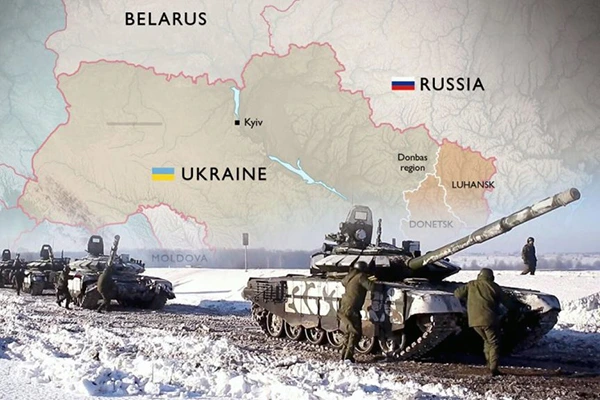The basic flaw in the Russian war fighting strategy in Ukraine has, perhaps, been Putin’s dogged insistence from the outset on keeping it “invasion lite.” This stemmed from his political imperative that the Ukrainians were Slav cousins and he did not want to alienate them in the long run. As such, Russia did not conform to its standard way of war that relies upon mass and high tech to simply steam-roll the enemy.
Russia attacked Ukraine with a force of just 1,50,000. Ukraine had 2,50,000 men in arms to start with. Later it mobilised fully to field about 5,50,000 men. Given that most of the fighting was in heavily built-up areas, the force ratios were badly skewed to start with. Despite this, it was amazing that the Russian forces encircled Kiev, secured almost 90% of Luhansk and 60% of Donetsk provinces and secured a land corridor to Crimea. They captured all Ukrainian ports on the Sea of Azov. Odessa was the only port left with Ukraine. Having met most of his minimal objectives, Putin started peace negotiations mediated by Turkiye. As a goodwill gesture he withdrew his forces from Kiev. The western media painted this as a rout of Russian forces. The Russian force was overstretched and exhausted after six months of fighting. By Jul-Aug 2022 the Ukrainians launched a much-heralded counter offensive in Kherson. The Russians had to pull out troops from Kharkiev to face this attack. The US satellites saw this gap. Americans encouraged Ukrainians to attack here even as Russian forces were withdrawing to the line of the Orkill river. On paper, this Ukrainian offensive looked like a brilliant Blitzkrieg and as it hit thin air and made rapid progress.
There was an outcry in Russia. Sergei Markov, and other pro-war Russians exhorted Putin to stop this strange phoney war (semi- war) in Ukraine and start a real war that Russia could win easily. Putin was forced to mobilise 3,00,000 reservists. The Syrian war combat vet, Gen Suvorvikin began construction of the three-tiered defence line using Russian construction companies. This 1200 km long Maginot line had deep minefields, anti-tank ditches and dragon teeth. Russia had realised that given the present state of technology, the advantage was clearly with the defender.
Operations in 2023
Meanwhile, the US and Nato helped create 9 new Ukrainian brigades equipped with a mish-mash of Leopard and Challenger tanks along with Bradley ICVs and Strykers. These were brand new formations and not combat-hardened troops. Ukrainians raised their 9th and 10th Strike Corps for the much-advertised counter-offensive in which they claimed they would throw Russians out of all captured territories. This Spring counter-offensive was finally launched on 4 June 2023. The attacks came in Zaporizhzhi and Bakhmut sectors.
There was strong difference of opinion between the Americans and Ukrainians about this splitting of forces. The Russian plan was based upon the Kursk battle of 1943, when the Russians had let the German Panzers attack first, inflicted heavy casualties with artillery and combat aviation and then switched to a major counter-offensive. The Russians had manned their first line with Spetsnaz troops, ATGMs and drones, who could vector down airstrikes and artillery fires. The Ukrainian attacks were led by mine-clearing trawl tanks and ploughs. This caused the attacking columns to bunch up and take heavy casualties. The Russians used their Kamov Ka-52 attack helicopters armed with the 7-10 km range Vykhir anti-tank missiles to destroy the Leopard and Challenger tanks from stand-off ranges. Su-24 ground attack aircraft and Russian artillery took a very heavy toll of attacking formations. Remotely delivered mines rapidly closed minefield safe-lanes behind trawl tanks. Most attacks could not make it even to the first Russian defence line.
By end-Jun, the Ukrainian offensive by their 9 Strike Corps had ended in a fiasco. There was great deal of recrimination between the Americans and Ukrainian generals. The Americans called the Ukrainians “casualty averse”. They berated them for frittering effort away in Bakhmut. When the Ukrainians resisted, the Americans forced Zelenskyy to sack his defence minister Reznikov and most top officials in the ministry. Investigations were launched into corruption scandals. Finally, in Aug, the Ukrainians resumed the offensive in Zaporizhzhia with their fresh 10 Corps. Under US pressure, they moved out some troops from Bakhmut, to this sector. They claimed to have breached the first defence line in Robotinye. The Russians also pulled out formations from their own Kupiansk counter-attack to plug this breach. Heavy losses were inflicted by Russian combat aviation, artillery and drones. Soon, this second corps-sized offensive also petered out with heavy losses. The new innovation was heavy Ukrainian investment in counter-battery (CB) fires to supress Russian artillery.
To draw media attention away from the glaring failure of the Ukrainian ground offensive, the Americans put pressure on the Ukrainians to mount major air attacks on the ports in Crimea and HQ of Russia’s Black Sea Fleet using Storm Shadow and Spice (French) cruise stand-off attack missiles. One Kilo-class submarine and a landing ship were damaged. Ukraine also mounted drone attacks on Moscow and other Russian cities. Though tactical damage was minimal, the psy ops value of these attacks was considerable and served to distract attention from the failure of the Ukrainian counter-offensive.
Meanwhile, Russia has conscripted some 2,70,000 additional troops and is readying for its major counter-offensive. Generals in Moscow have been urging Putin to expedite this offensive so as to seize and retain the initiative. So far, there are no clear indications of when this would materialise. This will, in all probability, be a winter offensive as the current campaign season is drawing to a close. Meanwhile, Russian retaliatory attacks on Kiev, Odessa and other cities have started to target the power grid, so Ukraine will have a miserable winter ahead. This battle will certainly stretch to 2024. However, the US NATO strategy of a long war to exhaust Russia may backfire. Already NATO members like Poland are feeling the fatigue and US funding has been halted temporarily.


















